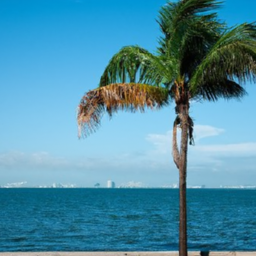In this article, you will learn about Miami’s efforts to combat climate change and the rising sea levels. Miami is at high risk due to its low-lying geography and porous limestone foundation, which makes it vulnerable to flooding. However, the city has taken several measures to manage the impacts of climate change and protect its residents. From investing in infrastructure projects to implementing stricter building codes, Miami is continuously working towards a sustainable future.
Miami’s response to climate change includes the implementation of green infrastructure projects, such as the creation of parks and wetlands to absorb and divert floodwaters. Additionally, the city has incorporated stricter building codes that require higher elevations for new constructions, protecting them from potential flood damage. Miami has also been actively engaging with experts and scientists to develop long-term strategies for climate mitigation. By prioritizing climate resilience and sustainability, Miami is taking important steps to adapt to the challenges posed by climate change and rising sea levels. Miami, a city known for its sandy beaches, vibrant culture, and bustling nightlife, is also facing the harsh reality of climate change and sea level rise. With its low elevation and coastal location, Miami is particularly vulnerable to the impacts of rising sea levels and extreme weather events. However, the city is not sitting idly by. Local government initiatives are being implemented to address these challenges head-on.
One of the key initiatives undertaken by the local government is the development of Climate Action Plans. These comprehensive plans outline strategies and policies to mitigate the effects of climate change and promote sustainable practices. They include measures to reduce carbon emissions, increase energy efficiency, and promote renewable energy sources. By setting clear goals and targets, Miami aims to become a leader in climate resilience.
Investment in resilient infrastructure is another crucial step taken by the city. Miami is retrofitting existing buildings and roads to withstand higher water levels and stronger storms. By elevating critical infrastructure, such as power plants, hospitals, and emergency response centers, the city can ensure the continuity of essential services during extreme weather events. This proactive approach is essential to safeguarding the well-being and safety of Miami’s residents.
Elevation of buildings and roads is also a key strategy being adopted by the city. By raising the height of structures, Miami can reduce the risk of flooding and minimize damage caused by storm surges. Moreover, elevated roads act as barriers, preventing water from infiltrating residential and commercial areas. This forward-thinking approach is a testament to Miami’s commitment to building a resilient and sustainable city.
Public awareness and education play a vital role in Miami’s efforts to combat climate change and sea level rise. The city has implemented various community engagement programs to educate residents and businesses about the impacts of climate change and the steps they can take to adapt. School curriculum integration ensures that future generations are equipped with the knowledge and skills to navigate the challenges posed by climate change. Public outreach campaigns further reinforce the importance of individual and collective action.
Coastal protection measures are also at the forefront of Miami’s resilience strategy. The construction of sea walls and barrier systems act as a defense against rising sea levels and storm surges. Beach nourishment projects replenish eroded beaches, preserving this vital natural resource and protecting coastal infrastructure. Dune restoration efforts not only enhance the aesthetic appeal of the coastline but also serve as a natural barrier against erosion and flooding.
Flood management strategies are essential in a city like Miami, prone to heavy rainfall and storm events. Improving drainage systems ensures that excess water is effectively channeled away from residential and commercial areas. Installation of pump stations enhances the city’s capacity to handle heavy rainfall and prevent flooding. Additionally, the implementation of floodplain regulations guides development in flood-prone areas, reducing the risk to both property and human life.
Water conservation and management are critical components of Miami’s climate resilience efforts. The promotion of water-efficient practices encourages residents and businesses to conserve water in their daily routines. The enhancement of water reuse systems allows for the recycling of treated wastewater for non-potable purposes, such as irrigation. Smart irrigation techniques also play a role in reducing water consumption and ensuring the efficient use of this precious resource.
Green infrastructure implementation is another key aspect of Miami’s resilience strategy. The planting of urban forests and the creation of green spaces not only enhance the city’s aesthetic appeal but also provide numerous environmental benefits. Urban forests absorb carbon dioxide, mitigate the urban heat island effect, and improve air quality. Green spaces act as natural filters, reducing stormwater runoff and preventing the accumulation of pollutants. Integration of sustainable stormwater management practices further contributes to Miami’s overall resilience.
Public-private partnerships are instrumental in Miami’s fight against climate change and sea level rise. Collaborating with businesses and nonprofits allows for the pooling of resources, knowledge, and expertise in developing and implementing resilience projects. Funding support for climate resilience projects ensures the availability of financial resources, particularly for large-scale initiatives. Shared research and innovation initiatives enable the city to stay at the forefront of climate adaptation and mitigation strategies.
Adaptive land use planning is also a key element in Miami’s resilience efforts. Updating zoning regulations to incorporate climate considerations ensures that development projects are designed with future climate conditions in mind. Designating climate impact zones helps identify areas at high risk of flooding or other climate-related hazards, guiding future development away from these vulnerable areas. By integrating climate considerations into development projects, Miami aims to create a more resilient and adaptive built environment.
Miami’s commitment to addressing climate change and sea level rise extends beyond its borders. Through international collaborations, the city participates in global climate change agreements, sharing knowledge and best practices with other cities facing similar challenges. Knowledge-sharing and exchange programs allow for the transfer of expertise, fostering innovation and resilience-building efforts. Joint research projects further contribute to the global understanding of climate change and its impacts.
In conclusion, Miami is taking proactive steps to address the challenges of climate change and sea level rise. Through local government initiatives, public awareness and education, coastal protection measures, flood management strategies, water conservation and management practices, green infrastructure implementation, public-private partnerships, adaptive land use planning, and international collaborations, Miami is positioning itself as a leader in climate resilience. The city’s holistic approach and commitment to sustainability serve as a model for other coastal communities worldwide. With continued efforts and collaboration, Miami is well on its way to building a more resilient and sustainable future.





